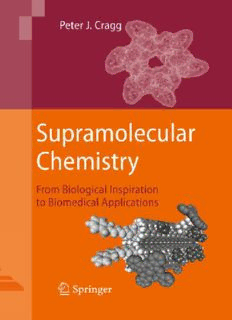
Supramolecular Chemistry PDF
Preview Supramolecular Chemistry
Supramolecular Chemistry Peter J. Cragg Supramolecular Chemistry From Biological Inspiration to Biomedical Applications 123 Dr.PeterJ.Cragg SchoolofPharmacyandBiomolecularSciences UniversityofBrighton HuxleyBldg,LewesRoad BN24GJBrighton UK [email protected] ISBN978-90-481-2581-4 e-ISBN978-90-481-2582-1 DOI10.1007/978-90-481-2582-1 SpringerDordrechtHeidelbergLondonNewYork LibraryofCongressControlNumber:2010932601 ©SpringerScience+BusinessMediaB.V.2010 Nopartofthisworkmaybereproduced,storedinaretrievalsystem,ortransmittedinanyformorby anymeans,electronic,mechanical,photocopying,microfilming,recordingorotherwise,withoutwritten permissionfromthePublisher,withtheexceptionofanymaterialsuppliedspecificallyforthepurpose ofbeingenteredandexecutedonacomputersystem,forexclusiveusebythepurchaserofthework. Printedonacid-freepaper SpringerispartofSpringerScience+BusinessMedia(www.springer.com) ForJamesandAlex Preface From its origins in the last quarter of the 20th Century the field of supramolecu- lar chemistry has expanded to encompass a vast amount of science carried out at thenanoscaleyetitisoftenforgottenthattheinitialinspirationforsupramolecular chemistscamefromtheworldofmolecularbiology.Biologicalprocessesconstruct complex,highlyfunctionalmolecularassembliesusinganarrayofreversibleinter- molecular forces. The balance between these forces lies at the heart of enzyme catalysis, DNA replication, the translation of RNA into proteins, transmembrane iontransport,andawealthofotherbiologicalphenomena.Pioneeringsupramolec- ular chemists sought to replicate the same complex and subtle interactions in the laboratorysothattheycouldmimicthehighlyefficientwaythatchemistryisdone inNature.Keytothesuccessofthefieldhasbeentheabilityofskilledscientiststo applytheirknowledgeoftheseinteractionstothedesignofunnaturalmolecules.As aconsequencetheyareabletopreparehighlyspecificsensors,imagingagentsand pharmaceuticals,manyofwhichareinwidespreadusetoday. Despiteanumberofexcellentbooksdevotedtosupramolecularchemistrythere are none that discuss its biological origins and biomedical applications in detail. The aim of this book is to return to the biomimicry and medicinal potential that inspired many of the early supramolecular chemists and to set it in the context of current advances in the field. It starts with an overview, covering the background to the field, the types of molecules and interactions commonly encountered, and methods for investigating the formation of supramolecules. In subsequent chap- ters parallels are drawn with biological phenomena: the formation of proteins and other biomolecules, self-replication and the origins of life, the evolution of cells, and the design of channel-forming molecules and enzymes. The application of supramolecularprinciplestosensorsandmagicbullettherapiesisexplainedandthe future of supramolecular therapeutics is considered. The exciting combination of supramolecular chemistry and nanotechnology is discussed together with the like- lihood that nanoengineered smart materials could one day circulate in the body, seeking out diseased cells or repairing damaged tissue, so that individuals could receivetreatmentevenbeforeanyhealthproblemswereapparent. Brighton,UK PeterJ.Cragg 11thMay2010 vii Acknowledgements ComputationalresultswereobtainedusingSpartan’08(WavefunctionInc.,Irvine, CA) and software programs from Accelrys Software Inc. with graphical displays generated by the Discovery Studio Visualizer. Where protein structures have been downloaded from the RCSB Protein Data Bank the full references and PDB IDs havebeengiven.IwishtoacknowledgetheuseoftheChemicalDatabaseService atDaresburyforaccesstoothercrystalstructures.Again,fullprimarysourcescan befoundinthereferences. I would like to thank the University of Brighton for the award of a University ResearchSabbaticalduringthesummerof2009. Finally, thanks to Margaret, Alex and James for their understanding while I workedonthisbook. ix
Description: